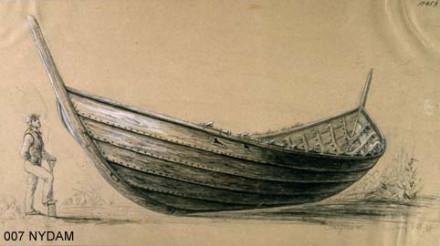History
The Nydam boat was found together with two other vessels in a bog in present-day Denmark. The ships are spoils of war, along with large quantities of weapons and other warfare equipment. The ship had been deliberately sunk in the fresh water lake after being hauled only a short distance over land. The ship has recently been dated via dendrochronology to 310–320 AD, and the deposition is likely to have taken place 340–350 AD.
Because of the outbreak of war between Denmark and Prussia in 1864, the excavations had to be cancelled, and the timbers of the Pine Ship were lost in the turmoil. With the conclusion of peace Denmark had to part with the Nydam find altogether, and the Nydam Oak Ship was moved from the former Danish town of Flensborg to Kiel in 1877. In 1941 the ship was moved again, and spent the rest of World War II on a barge on a lake, and was finally moved to the Archäologisches Landesmuseum in Schleswig where it is still on display.

Description
The Nydam boat is the oldest known rowed vessel from Northern Europe, and can be considered a forerunner of the Viking type longship.
It is a clinker-built rowing vessel of oak, built on a broad keel plank and consists of five strakes. The keel plank and the planks have carved out cleats for fastening the frames on the keel plank and the first four strakes; two for each frame and just one sturdy cleat on the fifth which at the same time accommodates the top of the frame and the thwart. The keel plank is made from one piece of oak 14.3 m long and 57 cm wide amidships tapering to about 20 cm at the ends.
The number of oars has been established with some certainty at 15 pairs, of which maybe one had been added during the working life of the ship.
- Length 22.84 m
- Width 3.26 m
